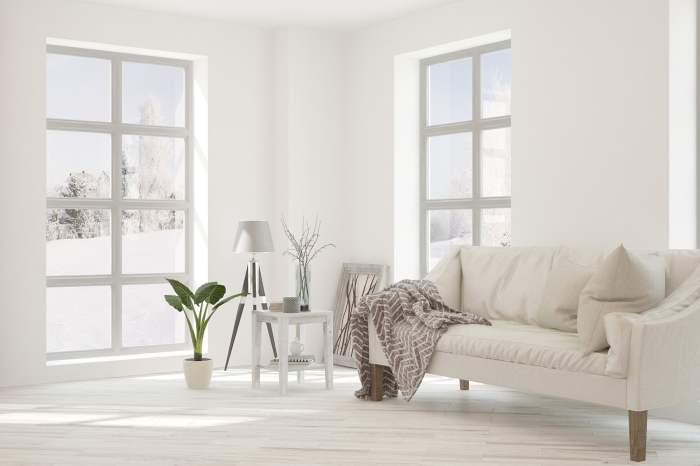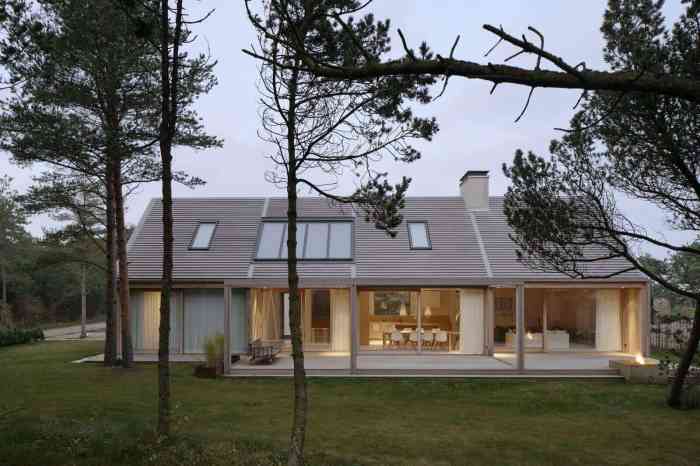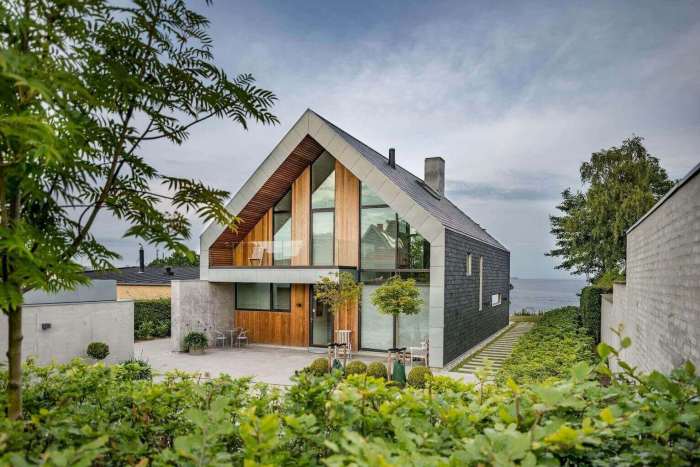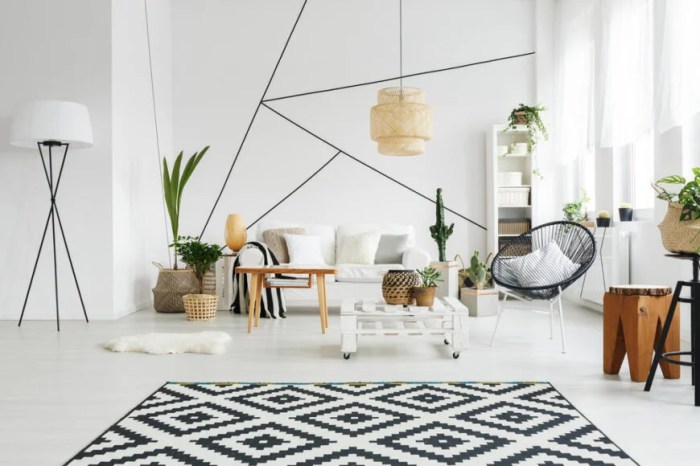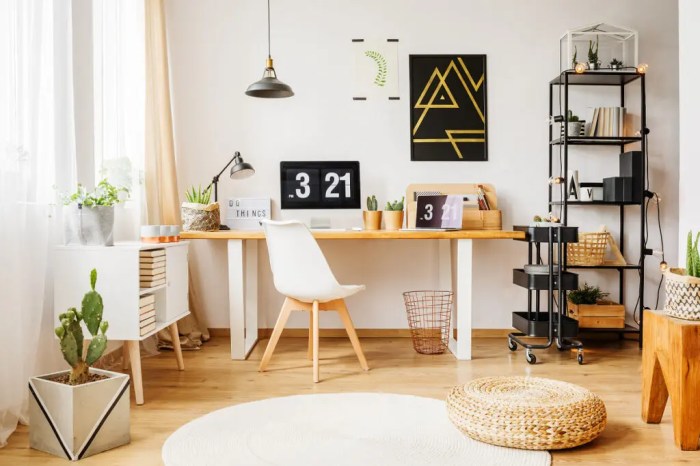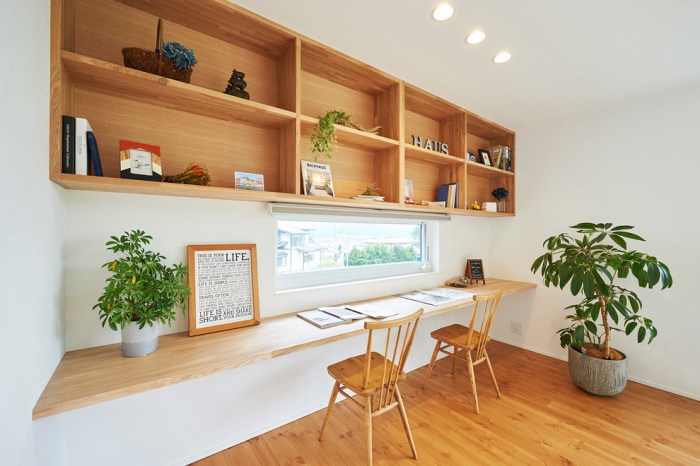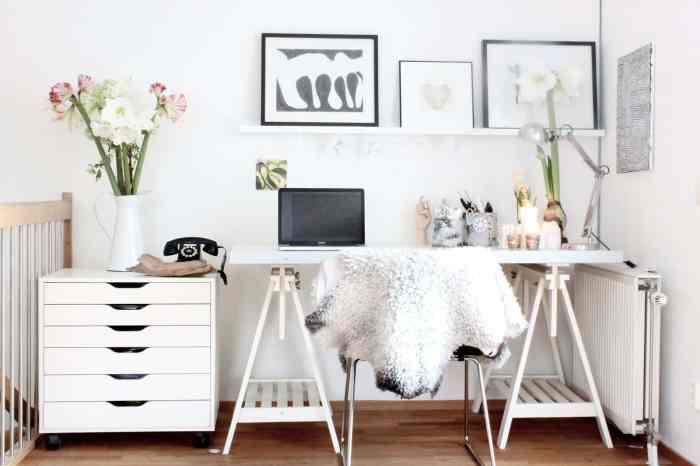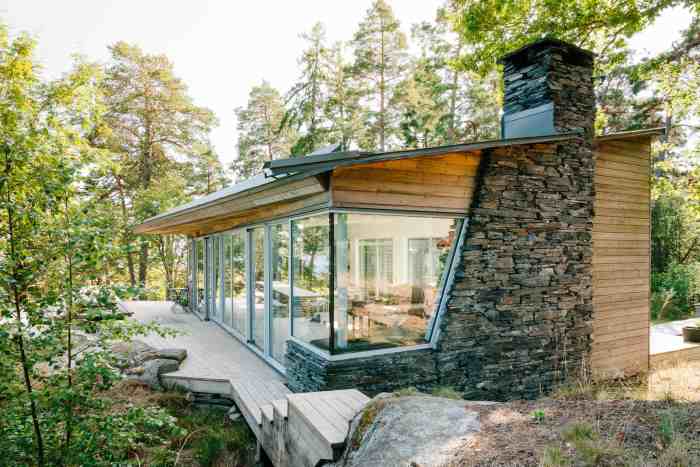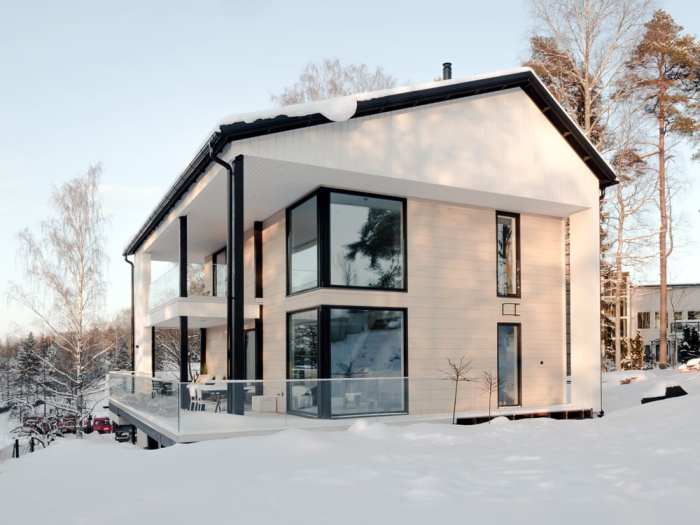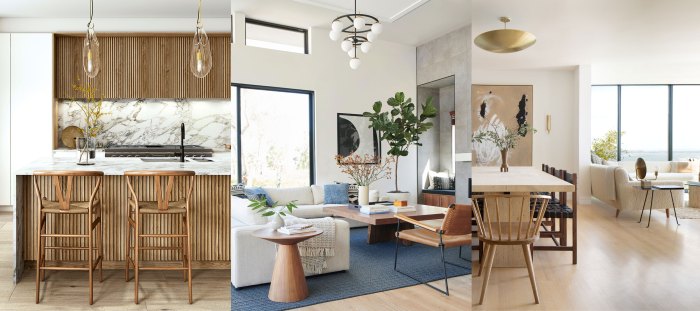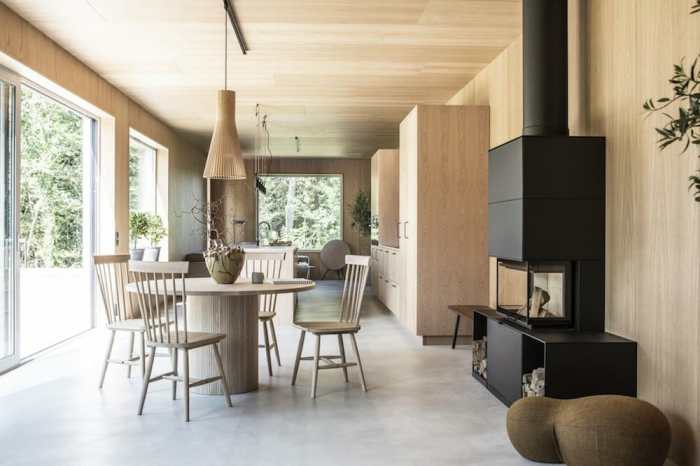Imagine a space where the serenity of minimalism meets the vibrant energy of the tropics. This is the essence of Tropical Minimalist Interior Design, a style that masterfully balances clean lines and uncluttered spaces with the warmth and natural beauty of lush vegetation and organic materials. It’s a design philosophy that transcends mere aesthetics; it’s about creating a sanctuary that nurtures the mind and body, a haven where tranquility and vibrancy coexist in harmonious balance.
The careful selection of materials, the strategic use of light, and the thoughtful integration of greenery all contribute to an atmosphere of calm sophistication.
This exploration delves into the core principles of Tropical Minimalist Interior Design, examining the interplay of minimalist aesthetics and tropical influences. We will explore material choices, color palettes, furniture selection, lighting strategies, and spatial planning, all while emphasizing the importance of incorporating natural elements to create a truly immersive and revitalizing living environment. The goal is to provide a comprehensive guide to designing and implementing this unique and increasingly popular style, providing practical advice and inspiring examples along the way.
Defining Tropical Minimalist Interior Design
Tropical minimalist interior design represents a fascinating synthesis of seemingly opposing aesthetics: the uncluttered simplicity of minimalism and the vibrant, exuberant energy of tropical environments. This style achieves a harmonious balance by carefully selecting and incorporating natural elements that evoke the tropics while maintaining a clean, unfussy spatial arrangement. The result is a space that feels both serene and invigorating, a sanctuary that connects the inhabitant to the natural world without sacrificing the elegance of minimalist principles.
Core Principles of Minimalist Design
Minimalism, at its core, prioritizes functionality and simplicity. It advocates for reducing clutter and maximizing space through the strategic use of essential furniture and decor. The philosophy emphasizes clean lines, neutral color palettes, and a focus on quality over quantity. This approach aims to create a sense of calm and order, allowing the inhabitant to focus on what truly matters.
A key aspect is the deliberate omission of unnecessary elements, fostering a feeling of spaciousness and tranquility. This principle is particularly effective in smaller spaces, where maximizing the perceived size and minimizing visual distractions is crucial.
Incorporating Tropical Elements into Minimalist Spaces
The integration of tropical elements within a minimalist framework requires a discerning eye. Instead of overwhelming the space with vibrant patterns and profuse ornamentation, the focus shifts to carefully curated natural materials and subtle allusions to tropical flora and fauna. This might involve incorporating natural wood furniture with clean lines, pieces crafted from bamboo or rattan, or the strategic use of indoor plants such as palms or ferns.
The textures of these natural materials add depth and visual interest without compromising the minimalist aesthetic. Furthermore, subtle color accents inspired by tropical landscapes – such as muted greens, sandy beige, and deep blues – can subtly evoke the feeling of a tropical paradise. The key is to carefully select and place these elements to enhance the overall minimalist design rather than detract from it.
Balancing Simplicity and Natural Elements
The success of tropical minimalist design lies in its delicate balance between simplicity and the incorporation of natural elements. It is a careful choreography of space, light, and texture. Too many tropical elements can overwhelm the minimalist aesthetic, while too little can render the space bland and lacking in character. The art lies in achieving a sense of effortless harmony, where the natural elements enhance the minimalist design rather than clashing with it.
This balance is achieved through careful consideration of scale, proportion, and color. For example, a single, large statement piece of tropical-inspired art might be more effective than a collection of smaller, cluttered items. Similarly, a carefully chosen palette of muted tropical colors can create a serene atmosphere without sacrificing the clean lines and uncluttered feel of a minimalist space.
Color Palettes in Tropical Minimalist Interiors
Common color palettes in tropical minimalist interiors often draw inspiration from the natural world. Muted greens, reminiscent of lush foliage, are frequently employed. Sandy beiges and creams evoke the feeling of warm beaches and sunlight. Deep blues, reflecting the tropical ocean, add a sense of tranquility and depth. These colors are often combined with accents of brighter, more saturated hues – such as a vibrant coral or a sunny yellow – to create a subtle but impactful contrast.
The overall effect is a calming and refreshing space that captures the essence of the tropics without being overly flamboyant. For instance, a living room might feature beige walls, natural wood furniture, and accents of teal and pale green, creating a harmonious blend of minimalist simplicity and tropical inspiration.
Material Selection and Texture
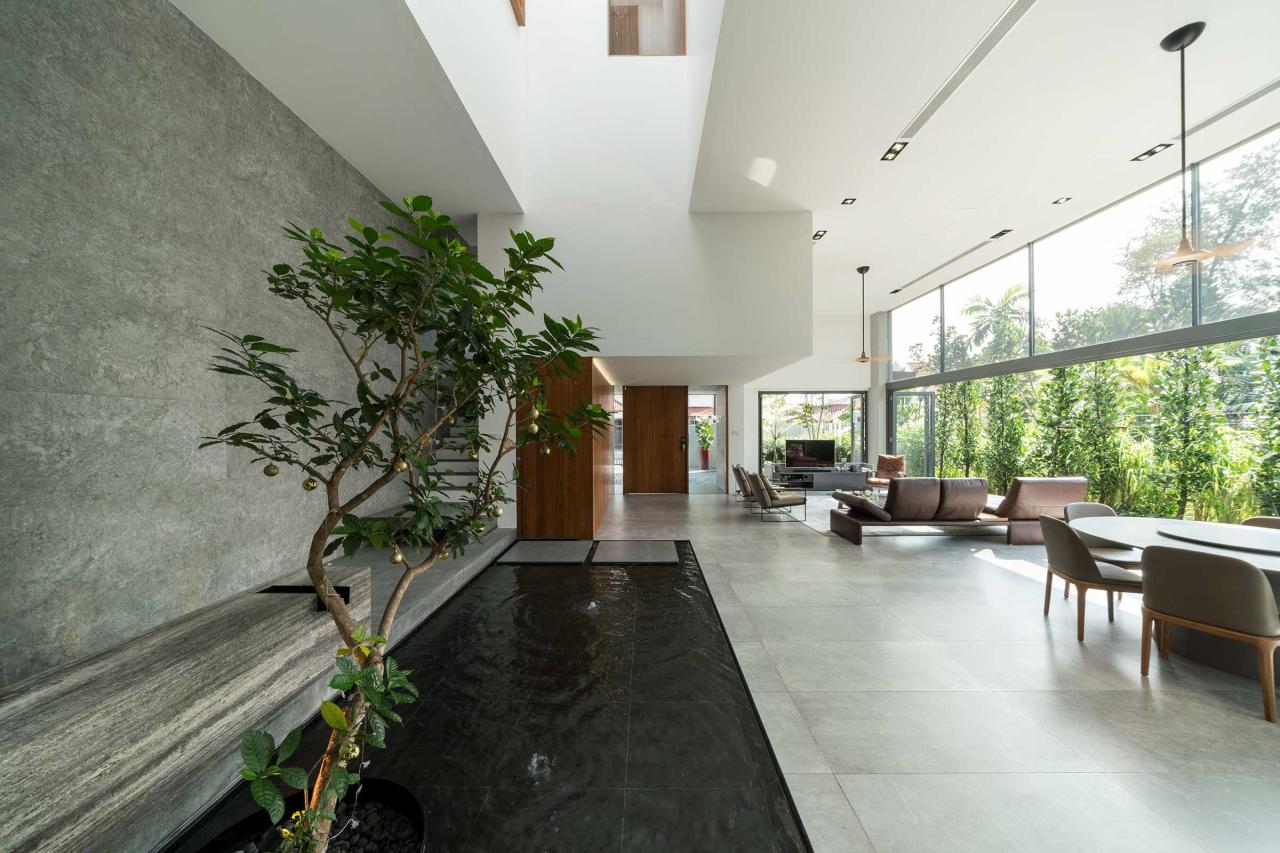
The essence of Tropical Minimalist interior design lies not only in its uncluttered aesthetic but also in the carefully curated selection of materials that evoke a sense of natural serenity and warmth. The tactile qualities of these materials, their textures, and their inherent connection to the tropical environment are crucial in achieving the desired calming and inviting atmosphere. This careful consideration extends beyond mere aesthetics; it involves understanding the thermal and acoustic properties of each material to optimize comfort and well-being.The judicious use of natural materials forms the bedrock of this design style.
The inherent properties of these materials, their sustainability, and their ability to age gracefully contribute to a space that feels both luxurious and environmentally conscious. The interplay of textures further enhances the sensory experience, creating a space that is not only visually appealing but also deeply engaging on a tactile level.
Natural Material Selection in Tropical Minimalist Design
Wood, bamboo, rattan, and stone are cornerstones of Tropical Minimalist design. The selection process prioritizes materials that are sustainably sourced and possess inherent qualities that complement the tropical climate. For instance, certain hardwoods, known for their durability and resistance to moisture, are ideal for flooring and furniture in humid environments. Bamboo, a rapidly renewable resource, offers a lighter, more airy alternative for accents and shelving, while rattan, with its intricate weave, adds a layer of visual interest and texture.
Stone, particularly locally sourced varieties, brings a sense of grounding stability and coolness to the space. The choice of each material is guided by its functional properties and aesthetic contribution to the overall design harmony.
The Role of Texture in Creating a Calming Atmosphere
Texture plays a pivotal role in shaping the sensory experience within a Tropical Minimalist space. The smooth coolness of polished stone contrasts beautifully with the warm, slightly rough texture of woven rattan or the subtle grain of natural wood. These contrasting textures create visual interest while contributing to a sense of calm and balance. The tactile experience, the feeling of cool stone underfoot or the subtle give of woven rattan furniture, enhances the overall sense of comfort and relaxation.
This carefully considered textural interplay is key to creating a space that feels both sophisticated and inviting. The absence of overly processed or synthetic materials further contributes to the feeling of tranquility, promoting a connection with nature and fostering a sense of well-being.
Sample Material Palette for a Tropical Minimalist Bedroom
A serene and functional tropical minimalist bedroom could incorporate the following material palette:
- Flooring: Wide-plank, light-toned teak wood, known for its durability and rich grain. Its slightly oily texture contributes to a warm, inviting feel.
- Walls: Smooth, light-colored plaster, providing a clean backdrop that enhances the natural textures of the other materials. Its matte finish avoids any harsh reflections.
- Furniture: A bed frame constructed from sustainably sourced bamboo, offering a lightweight yet robust structure. Rattan nightstands add a textural contrast and visual interest.
- Accents: Locally sourced river stone incorporated into a small, minimalist feature wall, introducing a grounding element and a pleasing textural contrast.
- Textiles: Natural linen bedding and cotton throws in muted, earthy tones, offering a soft tactile contrast to the harder surfaces.
Comparison of Wood Types in Tropical Minimalist Design
The choice of wood type significantly impacts the overall aesthetic and functionality of a Tropical Minimalist space. For instance, teak, with its inherent oiliness and resistance to decay, is ideal for flooring and outdoor furniture due to its durability in humid climates. Its rich grain adds warmth and character. In contrast, bamboo, a fast-growing grass, offers a lighter, more sustainable alternative for furniture and accents.
Its lighter color and smoother texture create a more airy and contemporary feel. Other woods, such as sustainably harvested mahogany or sustainably sourced oak, might be considered, but their selection depends on factors such as availability, cost, and the specific design aesthetic. The key is to choose wood species that align with sustainable practices and are appropriate for the specific climatic conditions.
Furniture and Furnishings
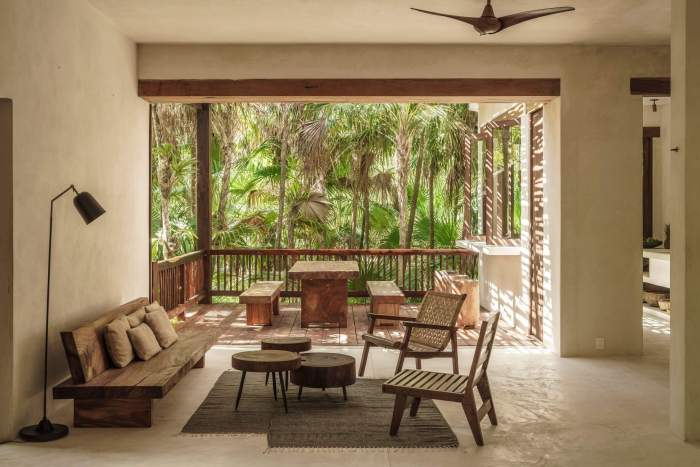
The selection of furniture and furnishings is paramount in achieving a successful tropical minimalist interior. The goal is to create a space that feels both airy and inviting, reflecting the natural beauty of tropical environments while maintaining a sense of calm and uncluttered simplicity. This necessitates a careful consideration of both form and function, prioritizing pieces that are both aesthetically pleasing and practical.
The principles of minimalism dictate a focus on essential items, carefully chosen to maximize space and enhance the overall ambiance.
The key to successfully integrating furniture into a tropical minimalist design lies in choosing pieces that are both functional and visually harmonious with the overall aesthetic. This involves selecting materials that reflect the natural environment and utilizing clean lines and simple forms to avoid visual clutter. The use of light and airy fabrics and natural materials creates a sense of spaciousness and openness, which is crucial in smaller spaces.
Key Furniture Pieces for a Tropical Minimalist Living Room
Suitable furniture for a tropical minimalist living room should prioritize clean lines, natural materials, and functionality. A low-profile sofa crafted from rattan or sustainably sourced wood, for example, offers both comfort and a visually appealing connection to nature. Similarly, a coffee table made from light-colored wood or bamboo adds to the airy feel without overwhelming the space. Consider a simple, yet comfortable armchair, perhaps in a natural linen fabric, for additional seating.
Storage solutions should be integrated seamlessly, perhaps with a sleek, minimalist shelving unit made from light wood to display a few carefully curated items. Avoid overly ornate or bulky pieces.
Minimalist Lighting Fixtures that Complement the Style
Lighting plays a crucial role in setting the mood and enhancing the ambiance of a tropical minimalist living room. Pendant lights made from natural materials such as bamboo or rattan offer a subtle, yet impactful, design element. These fixtures, often featuring simple geometric shapes, allow for a soft, diffused light that complements the overall aesthetic. Alternatively, strategically placed floor lamps with linen shades create a warm and inviting glow, particularly in the evening.
Avoid overly bright or harsh lighting; instead, opt for softer, more natural light sources to enhance the relaxing atmosphere. Recessed lighting can be used to provide ambient illumination, highlighting architectural details without distracting from the overall minimalist design.
Essential Accessories and Decorative Items
The minimalist approach doesn’t preclude the inclusion of accessories; rather, it emphasizes careful curation. A few carefully chosen items can significantly enhance the space without overwhelming it. A large, leafy green plant, such as a snake plant or ZZ plant, adds a touch of nature and improves air quality, scientifically proven to boost mood and well-being. A simple ceramic vase containing a few carefully arranged branches or flowers introduces a touch of elegance.
A woven wall hanging made from natural fibers adds texture and visual interest without being overly intrusive. Remember, the key is to avoid clutter and prioritize quality over quantity. Each item should serve a purpose and contribute to the overall aesthetic.
Furniture Arrangement for a Small Tropical Minimalist Apartment
In a small apartment, maximizing space and functionality is critical. For a small tropical minimalist living room, consider arranging furniture to optimize flow and create a sense of spaciousness. Place the sofa against a wall, leaving ample space for movement. The coffee table should be positioned centrally, providing easy access to seating. A floor lamp can be placed beside the sofa, providing task lighting while adding to the ambiance.
Consider using mirrors strategically to create the illusion of more space and reflect natural light. Keep the arrangement simple and uncluttered, focusing on creating a relaxing and functional space. Avoid overcrowding the room with furniture or accessories.
Color Schemes and Lighting
The interplay of light and color is paramount in achieving the serene and inviting atmosphere characteristic of tropical minimalist interiors. Natural light, filtered and diffused, plays a crucial role in shaping the overall ambiance, while carefully selected color palettes enhance the sense of spaciousness and tranquility inherent in this design style. The scientific principles of light perception and color psychology underpin the effective application of both elements.Natural light, rich in the full spectrum of wavelengths, positively impacts human well-being.
Studies show that exposure to natural light improves mood, sleep quality, and overall productivity. In tropical minimalist design, large windows and skylights maximize natural light penetration, creating a bright and airy space. The strategic placement of these openings minimizes harsh shadows, ensuring an even distribution of light throughout the room. Furthermore, the use of sheer curtains or blinds allows for adjustable light control, preventing glare while maintaining the connection with the outside environment.
This approach mirrors the natural lighting conditions found in lush tropical settings, where sunlight is filtered through dense foliage, creating a soft, dappled effect.
Light and Airy Color Palettes
Light and airy colors are fundamental to creating the sense of spaciousness crucial to tropical minimalist design. These colors, predominantly pastels and muted tones, reflect light effectively, visually expanding the room’s dimensions. The use of white, off-white, light beige, and soft shades of blue, green, and grey creates a calming and uncluttered atmosphere. The psychological impact of these colors is significant; lighter hues are associated with openness, cleanliness, and serenity, contributing to a feeling of calm and relaxation.
The selection of these colors is not arbitrary; it is informed by the understanding of how the human eye perceives color and space. Lighter shades recede visually, making the room appear larger than it actually is, a principle often employed in interior design to enhance the perceived size of smaller spaces.
Tropical Minimalist Mood Board
Imagine a mood board featuring three distinct color combinations. The first showcases a palette of creamy white walls, accented with soft sage green furniture and natural woven textures. The second features a base of pale grey, complemented by pops of vibrant turquoise in artwork and accessories, with accents of light wood. The third combination uses a light sandy beige as a backdrop, punctuated by the warm tones of terracotta pottery and natural rattan furniture, with accents of deep teal.
Each combination employs a limited color palette, ensuring visual harmony and a sense of calm. The textures used, such as linen, cotton, and natural wood, further enhance the minimalist aesthetic, reflecting the natural world that inspires the design style.
Warm and Cool Tone Comparisons
Warm tones, such as yellows, oranges, and reds, evoke feelings of warmth, energy, and comfort. In tropical minimalist design, warm tones are often used sparingly, as accents rather than dominant colors. They can introduce a sense of vibrancy and personality without overwhelming the overall serene atmosphere. Cool tones, including blues, greens, and purples, on the other hand, are associated with calmness, tranquility, and spaciousness.
These colors are often used as the primary palette in tropical minimalist interiors, reflecting the cool, refreshing feel of a tropical climate. The balance between warm and cool tones is crucial; a predominantly cool palette is often chosen for its ability to create a sense of spaciousness and tranquility, while strategically placed warm accents add depth and visual interest.
The effect is a harmonious blend that captures the essence of a relaxed tropical environment.
Incorporating Plants and Greenery
The integration of plants within a tropical minimalist interior design is not merely an aesthetic choice; it’s a crucial element that elevates the space’s functionality and overall well-being. Plants contribute significantly to air purification, reducing indoor pollutants like formaldehyde and benzene, as demonstrated by NASA Clean Air Study. Furthermore, their presence fosters a sense of tranquility and connection with nature, enhancing the calming atmosphere inherent in minimalist design.
The strategic use of greenery also helps to soften hard lines and add visual interest, enriching the overall sensory experience.The selection of plants for a tropical minimalist space necessitates a careful consideration of their maintenance requirements and suitability for indoor environments. Low-maintenance options thrive in the controlled conditions of a home, minimizing the time and effort required for upkeep.
Such plants not only enhance the aesthetic appeal but also contribute to a healthier living space.
Low-Maintenance Indoor Plants for Tropical Minimalist Design
Low-maintenance plants are essential for maintaining the clean lines and uncluttered aesthetic of a minimalist design. Overly demanding plants can detract from the intended simplicity. Choosing hardy varieties ensures the space remains visually appealing without requiring excessive attention.
- Snake Plant (Sansevieria trifasciata): Tolerates low light and infrequent watering, making it ideal for even the most neglectful plant owners. Its upright, sword-like leaves add a sculptural element to the space.
- ZZ Plant (Zamioculcas zamiifolia): Another champion of low light and infrequent watering, the ZZ plant’s dark green, glossy leaves provide a touch of elegance. Its drought tolerance aligns perfectly with the low-maintenance ethos of minimalist design.
- Cast Iron Plant (Aspidistra elatior): True to its name, this plant can withstand a wide range of conditions, including low light, infrequent watering, and temperature fluctuations. Its resilience makes it an excellent choice for busy individuals.
- Pothos (Epipremnum aureum): Highly adaptable, pothos can thrive in hanging baskets or climbing up walls, offering versatility in placement. Its variegated leaves add a pop of color without overwhelming the minimalist aesthetic.
Vertical Garden Design for a Tropical Minimalist Bathroom
Bathrooms, often characterized by their limited space, present an ideal opportunity for creative vertical gardening. A vertical garden in a tropical minimalist bathroom utilizes wall space effectively, introducing a lush, vibrant element while maintaining a clean, uncluttered look. The high humidity typical of bathrooms creates a favorable environment for many tropical plants.A sleek, minimalist vertical garden can be created using a modular system of self-watering planters made from materials like polished concrete or brushed stainless steel to complement the overall design aesthetic.
The planters can be arranged in a geometric pattern, creating a visually striking feature. Plants such as ferns ( Nephrolepis exaltata), which thrive in humid environments, or small orchids ( Phalaenopsis), known for their elegant blooms, are excellent choices. The overall design should emphasize clean lines and a unified color palette to avoid visual clutter. The use of LED grow lights ensures adequate light penetration, even in bathrooms lacking natural light.
Optimizing Plant Placement for Visual Impact
Strategic plant placement maximizes their visual impact within a tropical minimalist space. The goal is to enhance the design, not detract from it. Plants should be positioned to complement the existing architecture and furniture, rather than compete with them.Larger plants can serve as focal points, anchoring a seating area or drawing the eye to a particular feature. Smaller plants can be used to fill empty spaces or add pops of color to shelves or side tables.
Clustering plants of varying heights and textures creates visual depth and interest, while maintaining the overall minimalist aesthetic. Avoid overcrowding, allowing sufficient space between plants to prevent a cluttered appearance. Consider the natural light sources in the room and place plants accordingly, ensuring they receive the appropriate amount of sunlight. For example, a large, leafy plant might be placed near a window, while smaller, shade-tolerant plants can be placed in less sunny areas.
Space Planning and Layout
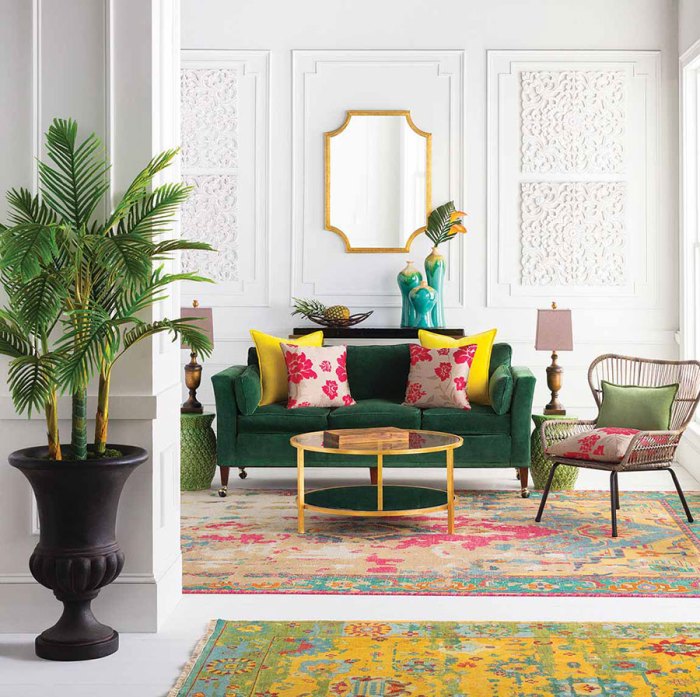
Effective space planning is paramount in tropical minimalist design, where the goal is to create a sense of openness and serenity while maximizing functionality. This involves careful consideration of furniture placement, traffic flow, and the strategic use of natural light and ventilation, all within the framework of a minimalist aesthetic. The principles of ergonomics and spatial psychology play crucial roles in achieving a harmonious and efficient living space.
Optimizing space in tropical minimalist interiors necessitates a thoughtful approach to layout and furniture selection. Multifunctional furniture and clever storage solutions are key to avoiding clutter and maintaining a clean, uncluttered atmosphere. The incorporation of natural light and ventilation not only enhances the aesthetic appeal but also contributes to a healthier and more comfortable living environment.
Tropical Minimalist Kitchen Layout
A well-designed tropical minimalist kitchen prioritizes functionality and ease of movement. The following table illustrates a sample layout for a small kitchen, utilizing a four-column responsive design adaptable to various space sizes.
| Column 1 | Column 2 | Column 3 | Column 4 |
|---|---|---|---|
| Sink and Dishwasher | Counter Space/Prep Area | Stovetop and Oven | Refrigerator |
|
Vertical storage (tall pantry cabinet) |
Open shelving for dishes and cookware |
Spice rack |
Small, built-in microwave |
This layout promotes efficient workflow, minimizing steps between tasks. The use of light-colored cabinetry and countertops enhances the sense of spaciousness. The incorporation of natural materials like bamboo or light-colored wood adds to the tropical minimalist aesthetic.
Maximizing Space in a Small Tropical Minimalist Apartment
In small apartments, maximizing space is critical. This involves strategic use of vertical space, multi-functional furniture, and built-in storage. For example, a sofa bed combines seating and sleeping functions, while wall-mounted shelves and drawers free up floor space. Mirrors strategically placed can create an illusion of greater space, reflecting light and visually expanding the room. Utilizing light and airy colors further contributes to this effect.
A well-designed apartment can feel spacious and uncluttered despite its limited square footage.
Tropical Minimalist Bedroom Layout
A tropical minimalist bedroom should prioritize relaxation and tranquility. The bed is the focal point, positioned to maximize natural light and views. Minimalist bedside tables and a streamlined wardrobe maintain a clean aesthetic. Incorporating natural materials such as rattan or bamboo adds warmth and texture without overwhelming the space. Adequate lighting, both natural and artificial, is essential for creating a comfortable and inviting atmosphere.
A simple, uncluttered design promotes a restful environment.
Importance of Open Floor Plans in Tropical Minimalist Design
Open floor plans are integral to tropical minimalist design. They promote a sense of spaciousness and airflow, allowing natural light to penetrate deeper into the living space. By removing walls and barriers, open floor plans create a seamless flow between different areas of the home, enhancing both functionality and aesthetic appeal. This interconnectedness is particularly beneficial in tropical climates, fostering a sense of connection with the outdoors.
The visual expanse creates a feeling of calm and serenity, reflecting the core principles of tropical minimalist design. This open concept aligns with the natural flow of tropical environments, mirroring the fluidity of nature.
Illustrative Examples
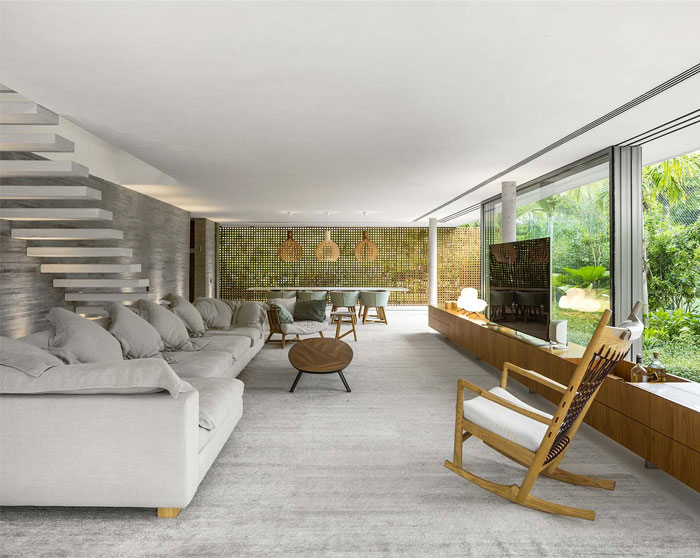
The following examples demonstrate the application of tropical minimalist design principles across various spaces within a home. Each design prioritizes functionality, natural light, and a curated selection of materials to create serene and inviting environments. The use of biophilic design—integrating natural elements into the built environment—is a key component, promoting a sense of well-being and connection to nature.
Tropical Minimalist Bedroom
This bedroom embodies tranquility. The color palette centers on muted greens, reminiscent of lush foliage, paired with creamy whites and light beige accents. The walls are painted a soft, sage green, providing a calming backdrop. The flooring consists of light-colored bamboo, chosen for its sustainable nature and inherent warmth. Furniture is minimal: a low platform bed made of sustainably sourced teak wood, a simple nightstand crafted from woven rattan, and a built-in wardrobe with clean lines.
Lighting is soft and indirect, achieved through a combination of recessed ceiling lights and a bedside lamp with a linen shade, emitting a warm, inviting glow. A single, large-leafed plant, such as a bird of paradise, adds a touch of vibrant greenery.
Tropical Minimalist Living Room
Natural light is maximized in this living room through large windows and sliding glass doors that seamlessly connect the interior with an outdoor patio. The space is defined by a neutral color scheme—off-white walls, light grey sofa, and natural-fiber rugs—allowing the abundant sunlight to illuminate the room. The sofa is upholstered in a linen fabric, providing a tactile and breathable surface.
A low coffee table made from reclaimed wood anchors the seating area. Strategically placed potted plants, including various sizes of snake plants and ZZ plants known for their air-purifying qualities (NASA Clean Air Study), introduce verticality and texture. Indirect lighting, through floor lamps with woven shades and strategically placed pendant lights, complements the natural light, creating a warm ambiance in the evenings.
Tropical Minimalist Bathroom
This bathroom showcases the beauty of natural materials. The walls are clad in smooth, light-grey stone tiles, mimicking the texture of river stones. The flooring is composed of large, polished concrete tiles, offering a cool, durable surface. A freestanding bathtub made from white ceramic, with clean, simple lines, is the focal point. A floating vanity made from sustainably harvested wood provides ample storage.
The shower features a rainfall showerhead and glass enclosure, maximizing the sense of spaciousness. Natural light filters in through a frosted glass window, creating a soft, diffused glow. The use of natural fiber bath mats and towels adds a textural element, while a small succulent placed on the vanity adds a touch of living greenery. The overall effect is one of calm and serenity.
Tropical Minimalist Dining Area
This dining area features a simple yet elegant design. A long, rectangular dining table made from light-colored wood dominates the space. The chairs are minimalist in design, with clean lines and upholstered in a natural-toned linen fabric. A simple pendant light, crafted from woven rattan, hangs above the table, providing soft, ambient lighting. A large woven rug, in a natural jute fiber, defines the dining area and adds warmth underfoot.
Minimalist decor includes a simple centerpiece of dried tropical flowers and leaves, echoing the overall aesthetic. The overall effect is clean, functional, and effortlessly stylish.
Final Review
Tropical Minimalist Interior Design offers a refreshing approach to modern living, seamlessly blending the simplicity of minimalism with the vibrant energy of tropical landscapes. By thoughtfully incorporating natural materials, strategic lighting, and carefully chosen plants, we can create spaces that are not only aesthetically pleasing but also promote a sense of calm and well-being. The key lies in achieving a delicate balance – a harmony between the clean lines of minimalist design and the rich textures and colors inspired by nature.
The result is an environment that is both visually stunning and deeply restorative, a true testament to the power of thoughtful design to enhance our lives.
FAQ Insights
What are the common misconceptions about Tropical Minimalist design?
A common misconception is that it’s solely about using bright colors and abundant plants. While these elements are often incorporated, the core principle remains minimalism – clean lines, uncluttered spaces, and a focus on functionality.
How can I incorporate Tropical Minimalist design into a small space?
Maximize natural light, use light and airy colors, choose multi-functional furniture, and strategically place mirrors to create an illusion of spaciousness. Vertical gardening is also excellent for small spaces.
What are some budget-friendly ways to achieve this style?
Source affordable natural materials like bamboo or reclaimed wood. Shop for secondhand furniture and repurpose existing items. Incorporate DIY elements like creating your own vertical garden.
How do I maintain the plants in a Tropical Minimalist interior?
Select low-maintenance plants suited to indoor conditions. Research their specific light and watering needs. Regularly check for pests and diseases.
Can this style be adapted to different climates?
Yes, the core principles of minimalism and the use of natural materials can be adapted to any climate. The specific plant choices and materials might vary based on regional availability and climate suitability.
